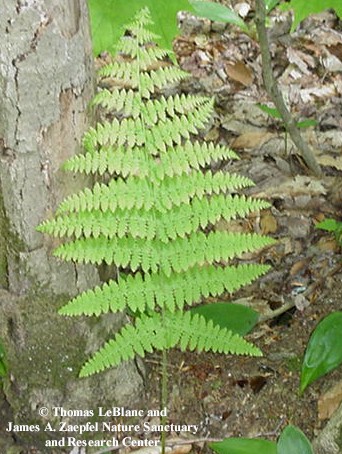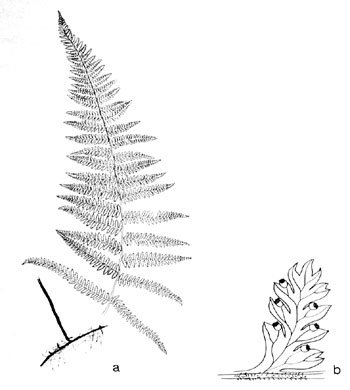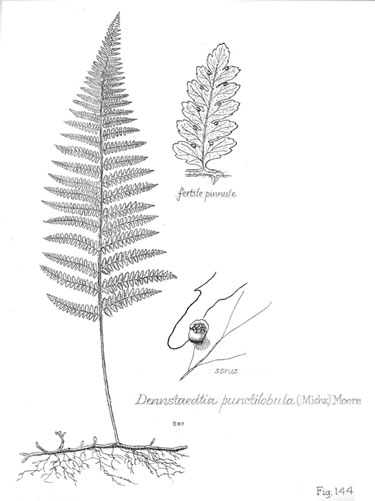|
Hardy Fern Home D. punctilobula resources
All Ferns � Dennstaedtiaceae �� Dennstaedtia
�Other Genera
|
| Dennstaedtia punctilobula | ||
Hay-scented fern | ||
|
Etymology
From punctum, a spot, + lobus, a lobe. Refers to the spore dots on the lobes.
Description
Rhizome: long-creeping, slender, just below the surface, hairs dark reddish brown, jointed.
Frond: 70 cm high by 25 cm wide, deciduous, monomorphic, blade/stipe ratio: 2:1 to 3:1. Stipe: straw-colored to brown, darker at base, grooved above, pubescent with white, soft, jointed hairs, vascular bundles: 1, in a U-shape. Blade: 2-pinnate-pinnatifid, lanceolate, lacy, papery, yellow-green, silver-gray, jointed hairs on both surfaces, tipped with white glands. Pinnae: 10 to 25 pair, broadest at the base; segments ovate to lanceolate, margins serrate-crenate; margins deeply lobed, serrate-crenate; veins free, pinnately branched. Sori: globose to almost cylindric, marginal at vein tips, indusium: formed by fusion of inner and outer laminar flaps to form a circular, small cup, whitish, at the margin and in from the margin, sporangia: brown, maturity: midsummer. Dimensionality: pinnae twisted somewhat out of plane of blade, the lowest pair also bending above the plane and towards the base. Culture
Habitat: open or thinly shaded areas .
Distribution: eastern and northeastern North America.
Hardy to -35�C, USDA Zone 3.
Distinctive Characteristics
Sometimes a hay scent when bruised, aggressive, forming colonies, yellow-green color, hairy, yellowing early in fall.
Synonyms
Nephrodium punctilobulum Michaux Aspidium punctilobulum Sw. |
|
|

Dennstaedtia punctilobula. Vascular bundle an inverted u-shape at both top (above)�and bottom of the stipe; front of the stipe is below. �Drawing from Ferns of Northeastern United States, Farida A. Wiley, 1936. |

a single frond, an unusual occurrence for this gregarious socialite �James A. Zaepfel Nature Sanctuary and Research Center |

Dennstaedtia punctilobula. a) rhizome, frond; b) pinnule, sori. �Illustration by V. Fulford from Ferns and Fern Allies of Canada, William J. Cody and Donald M. Britton, 1989, � Agriculture Canada, used with permission. |
